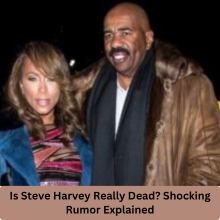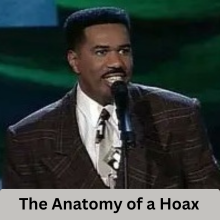Steve Harvey
In an age where misinformation spreads like wildfire, it’s alarming to see prominent figures like comedian Steve Harvey become the target of death hoaxes. Since early 2024, social media platforms have been buzzing with false claims about Harvey’s death following a supposed “tragic accident.” This article will dissect the origins of these rumors, their spread, and the impact they have on public perception. Let’s dive into the details!
Understanding the Rumor Mill
What Sparked the Rumor?
Rumors about Steve Harvey’s demise began circulating around October 2024, with posts on platforms like Facebook and misleading videos on YouTube. A user claimed he had died in a car accident, which quickly escalated into a widespread narrative.
The Role of Social Media
Social media is a double-edged sword; while it allows for the rapid sharing of information, it also facilitates the spread of false claims. Posts on platforms like Facebook often go viral without verification, leading to widespread panic among fans.
Debunking the Myths
Fact-Checking the Claims
A simple check of Steve Harvey’s ongoing projects, such as “The Steve Harvey Morning Show,” confirmed he was alive and well as of October 17, 2024. This highlights the importance of fact-checking before believing and spreading rumors.
Response from Steve Harvey’s Team
When reached for comment, a representative for Harvey chose not to address the rumors directly. However, Harvey himself previously responded to similar hoaxes, showcasing his humorous side. In July 2023, he shared a picture of himself looking at his phone with the caption, “Me seeing that Rip Harvey is trending.”
The Anatomy of a Hoax
Common Characteristics of Death Hoaxes
Death hoaxes often share several traits:
- Vague Sources: They rarely cite credible sources.
- Emotional Appeals: They play on emotions, encouraging people to share out of concern.
- Sensationalism: Titles often exaggerate or dramatize the situation.
Specific Examples from Social Media
On October 17, one Facebook user posted about Harvey’s supposed passing, claiming it was breaking news. This was met with confusion and disbelief from many followers, prompting them to share their concerns.
YouTube: A Hotbed for Misinformation
Misleading Content
YouTube has become a platform where misinformation flourishes. Videos with sensational titles like “Devastating News… In a Tragic Accident Yesterday Night, Steve Harvey Passed Away…” have garnered views based on shock value rather than factual accuracy.
The Clickbait Culture
The allure of clickbait is undeniable. Many creators prioritize views over truth, often resorting to misleading thumbnails and titles to capture attention. This not only misleads viewers but also damages the reputation of those being discussed.
The Economic Angle
Monetization of Misinformation
A troubling trend is the monetization of these hoaxes through advertising. Companies have been found paying to promote these false narratives, capitalizing on the public’s curiosity and concern for Steve Harvey.
Meta’s Role
Meta’s ad library shows that advertisers have been promoting these death hoaxes about Harvey for months. Ads claiming “Steve Harvey Dead? ‘Family Feud’ Fans React To Host’s Death Trending!” not only mislead users but also drive traffic to questionable apps.
Also read: Is Covid XEC the Next Big Threat? Discover the Symptoms Now
Impact on Steve Harvey’s Brand
Public Reaction
While most fans have expressed disbelief and concern over the rumors, such hoaxes can have detrimental effects on a celebrity’s brand. Continuous false claims can lead to a decline in public trust and engagement.
The Humor Factor
Despite the serious nature of these rumors, Steve Harvey’s approach has often been humorous. He tends to take these situations lightly, using his platform to engage with fans and clarify misinformation.
The Bigger Picture
The Importance of Critical Thinking
As consumers of media, it’s crucial to approach sensational news with a critical eye. Engaging in critical thinking can help individuals discern fact from fiction, especially in today’s digital age.
Lessons Learned from This Incident
This incident serves as a reminder of the power of social media and the responsibility that comes with it. Sharing information without verification can perpetuate harm, not just to public figures but to the broader community.
Also read: Zendaya’s Reaction to ‘Spider-Man 4’ Script Will Shock You!
Conclusion
The false rumor claiming comedian Steve Harvey died in a tragic accident is a clear example of how misinformation can spiral out of control. By taking a moment to verify facts, we can help reduce the spread of harmful rumors and protect the integrity of public figures. Remember, just because something is trending doesn’t make it true!
FAQs
How did the Steve Harvey death rumor start?
The rumor began on social media, particularly Facebook, where users posted false claims about his death following a supposed car accident.
Is Steve Harvey alive?
Yes, as of October 17, 2024, Steve Harvey is very much alive, confirmed through his ongoing radio show and podcast.
Why do death hoaxes happen?
Death hoaxes often arise from the desire to attract attention, generate clicks, or manipulate public sentiment for economic gain.
What should I do if I see a rumor about a celebrity’s death?
Always verify the information through credible sources before sharing. Fact-checking can help prevent the spread of misinformation.
How can I protect myself from misinformation on social media?
Engage in critical thinking, check multiple reliable sources, and be skeptical of sensational headlines and clickbait content.


